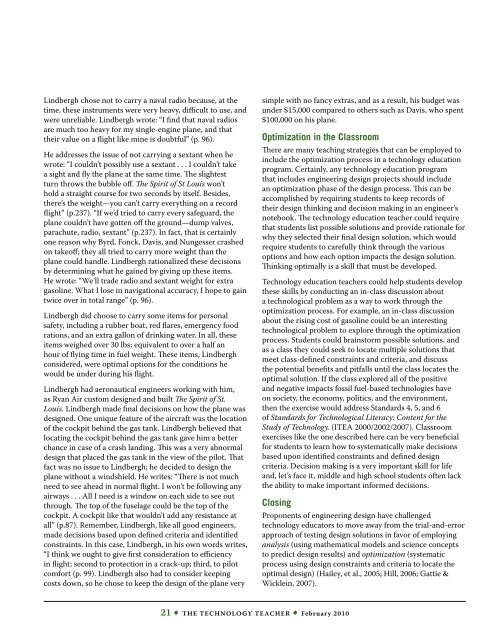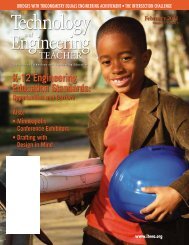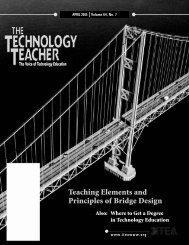February - Vol 69, No 5 - International Technology and Engineering ...
February - Vol 69, No 5 - International Technology and Engineering ...
February - Vol 69, No 5 - International Technology and Engineering ...
You also want an ePaper? Increase the reach of your titles
YUMPU automatically turns print PDFs into web optimized ePapers that Google loves.
Lindbergh chose not to carry a naval radio because, at the<br />
time, these instruments were very heavy, difficult to use, <strong>and</strong><br />
were unreliable. Lindbergh wrote: “I find that naval radios<br />
are much too heavy for my single-engine plane, <strong>and</strong> that<br />
their value on a flight like mine is doubtful” (p. 96).<br />
He addresses the issue of not carrying a sextant when he<br />
wrote: “I couldn’t possibly use a sextant . . . I couldn’t take<br />
a sight <strong>and</strong> fly the plane at the same time. The slightest<br />
turn throws the bubble off. The Spirit of St Louis won’t<br />
hold a straight course for two seconds by itself. Besides,<br />
there’s the weight—you can’t carry everything on a record<br />
flight” (p.237). “If we’d tried to carry every safeguard, the<br />
plane couldn’t have gotten off the ground—dump valves,<br />
parachute, radio, sextant” (p.237). In fact, that is certainly<br />
one reason why Byrd, Fonck, Davis, <strong>and</strong> Nungesser crashed<br />
on takeoff; they all tried to carry more weight than the<br />
plane could h<strong>and</strong>le. Lindbergh rationalized these decisions<br />
by determining what he gained by giving up these items.<br />
He wrote: “We’ll trade radio <strong>and</strong> sextant weight for extra<br />
gasoline. What I lose in navigational accuracy, I hope to gain<br />
twice over in total range” (p. 96).<br />
Lindbergh did choose to carry some items for personal<br />
safety, including a rubber boat, red flares, emergency food<br />
rations, <strong>and</strong> an extra gallon of drinking water. In all, these<br />
items weighed over 30 lbs; equivalent to over a half an<br />
hour of flying time in fuel weight. These items, Lindbergh<br />
considered, were optimal options for the conditions he<br />
would be under during his flight.<br />
Lindbergh had aeronautical engineers working with him,<br />
as Ryan Air custom designed <strong>and</strong> built The Spirit of St.<br />
Louis. Lindbergh made final decisions on how the plane was<br />
designed. One unique feature of the aircraft was the location<br />
of the cockpit behind the gas tank. Lindbergh believed that<br />
locating the cockpit behind the gas tank gave him a better<br />
chance in case of a crash l<strong>and</strong>ing. This was a very abnormal<br />
design that placed the gas tank in the view of the pilot. That<br />
fact was no issue to Lindbergh; he decided to design the<br />
plane without a windshield. He writes: “There is not much<br />
need to see ahead in normal flight. I won’t be following any<br />
airways . . . All I need is a window on each side to see out<br />
through. The top of the fuselage could be the top of the<br />
cockpit. A cockpit like that wouldn’t add any resistance at<br />
all” (p.87). Remember, Lindbergh, like all good engineers,<br />
made decisions based upon defined criteria <strong>and</strong> identified<br />
constraints. In this case, Lindbergh, in his own words writes,<br />
“I think we ought to give first consideration to efficiency<br />
in flight; second to protection in a crack-up; third, to pilot<br />
comfort (p. 99). Lindbergh also had to consider keeping<br />
costs down, so he chose to keep the design of the plane very<br />
simple with no fancy extras, <strong>and</strong> as a result, his budget was<br />
under $15,000 compared to others such as Davis, who spent<br />
$100,000 on his plane.<br />
Optimization in the Classroom<br />
There are many teaching strategies that can be employed to<br />
include the optimization process in a technology education<br />
program. Certainly, any technology education program<br />
that includes engineering design projects should include<br />
an optimization phase of the design process. This can be<br />
accomplished by requiring students to keep records of<br />
their design thinking <strong>and</strong> decision making in an engineer’s<br />
notebook. The technology education teacher could require<br />
that students list possible solutions <strong>and</strong> provide rationale for<br />
why they selected their final design solution, which would<br />
require students to carefully think through the various<br />
options <strong>and</strong> how each option impacts the design solution.<br />
Thinking optimally is a skill that must be developed.<br />
<strong>Technology</strong> education teachers could help students develop<br />
these skills by conducting an in-class discussion about<br />
a technological problem as a way to work through the<br />
optimization process. For example, an in-class discussion<br />
about the rising cost of gasoline could be an interesting<br />
technological problem to explore through the optimization<br />
process. Students could brainstorm possible solutions, <strong>and</strong><br />
as a class they could seek to locate multiple solutions that<br />
meet class-defined constraints <strong>and</strong> criteria, <strong>and</strong> discuss<br />
the potential benefits <strong>and</strong> pitfalls until the class locates the<br />
optimal solution. If the class explored all of the positive<br />
<strong>and</strong> negative impacts fossil fuel-based technologies have<br />
on society, the economy, politics, <strong>and</strong> the environment,<br />
then the exercise would address St<strong>and</strong>ards 4, 5, <strong>and</strong> 6<br />
of St<strong>and</strong>ards for Technological Literacy: Content for the<br />
Study of <strong>Technology</strong>. (ITEA 2000/2002/2007). Classroom<br />
exercises like the one described here can be very beneficial<br />
for students to learn how to systematically make decisions<br />
based upon identified constraints <strong>and</strong> defined design<br />
criteria. Decision making is a very important skill for life<br />
<strong>and</strong>, let’s face it, middle <strong>and</strong> high school students often lack<br />
the ability to make important informed decisions.<br />
Closing<br />
Proponents of engineering design have challenged<br />
technology educators to move away from the trial-<strong>and</strong>-error<br />
approach of testing design solutions in favor of employing<br />
analysis (using mathematical models <strong>and</strong> science concepts<br />
to predict design results) <strong>and</strong> optimization (systematic<br />
process using design constraints <strong>and</strong> criteria to locate the<br />
optimal design) (Hailey, et al., 2005; Hill, 2006; Gattie &<br />
Wicklein, 2007).<br />
21 • The <strong>Technology</strong> Teacher • <strong>February</strong> 2010
















